|
|
|
Huperzia phlegmaria
(L.) Rothm.
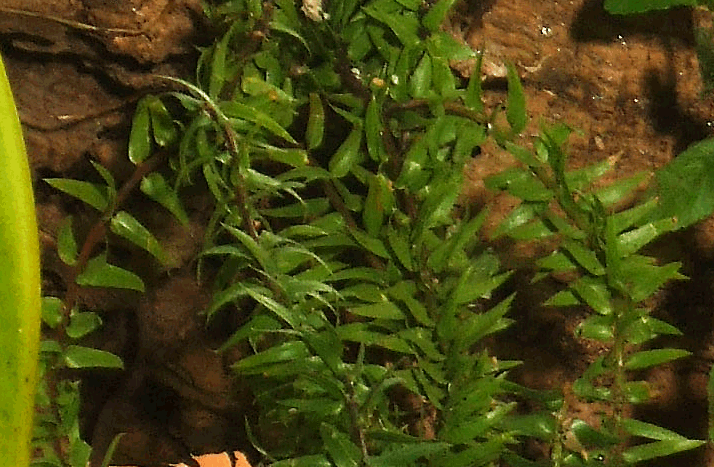 Huperzia phlegmaria (L.) Rothm. Common names: Lycopodium fern, Coarse tassel fern, Tassel fern Synonyms: Lycopodium phlegmaria L, Lepidotis phlegmaria (L.) P. Beauv., Phlegmariurus phlegmaria (L.) Holub, Phlegmariurus phlegmaria (L.) U. Sen & T. Sen, Urostachys phlegmaria (L.) Herter ex Nessel 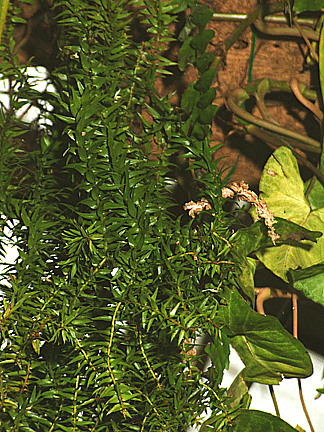 A
member of the family Lycopodiaceae. Huperzia phlegmaria is
not a fern as can often be read on the internet. Instead it is
a club moss known as a Lycophyte. Within the genus
Huperzia can be found the Fir mosses or Fir club mosses.
Originally published to science in Feddes Repert. Spec. in 1944,
the correct name of Huperzia phlegmaria was verified on
January 12, 1999 by ARS Systematic Botanists. In the rules of
botany the first name published for a species becomes the
basionym (base name) while all other published names for the
same species are considered synonyms. The name has not been
changed as is often thought by collectors. Instead, the correct
originally published name has simply been verified as
Huperzia phlegmaria. A
member of the family Lycopodiaceae. Huperzia phlegmaria is
not a fern as can often be read on the internet. Instead it is
a club moss known as a Lycophyte. Within the genus
Huperzia can be found the Fir mosses or Fir club mosses.
Originally published to science in Feddes Repert. Spec. in 1944,
the correct name of Huperzia phlegmaria was verified on
January 12, 1999 by ARS Systematic Botanists. In the rules of
botany the first name published for a species becomes the
basionym (base name) while all other published names for the
same species are considered synonyms. The name has not been
changed as is often thought by collectors. Instead, the correct
originally published name has simply been verified as
Huperzia phlegmaria.Huperzia phlegmaria is an epiphytic species of tassel like club moss native to rain forests in Madagascar, some islands in the Indian Ocean, Asia, Australia as well as many Pacific Islands. The species has been reported on scientific sources as having been collected in Madagascar, Vietnam, New Caledonia , and Vanuatu, in the United Republic of Malawi, Thailand, Papau/New Guinea, Tanzania, Sierra Leone,São Tomé and Príncipe; São Tomé and Príncipe and New Caledonia. Collectors from the Malaysian peninsula have also reported collections in their region (scientifically unconfirmed) and it is likely found in many other neighboring countries and regions.
H. phlegmaria is a variable species
and plants from different regions can vary widely in shape.
Simply because a plant is
-6.gif) a "species" does not mean it has a
single bodily form. The species can be identified by
having sterile microphylls on the petioles (stems) and small
fertile microphylls on the thin and branching strobili.
A microphyll is considered an appendage supplied by a single
vein which is unbranched. Despite the name, the microphylls
are not always microscopic. The strobilus, which is the
singular of strobili, is an organ of many plants that contains
the reproductive system of the species. Huperzia
phlegmaria is a pendulous (hanging) epiphyte (ep-a-FIT) which is
dichotomously branched. Dichotomous simply means
divided or dividing into two parts or classifications. The
leaves are lanceolate (lance shaped) and narrow or rounded at
the base then even more strongly narrowed at the extreme base.
The leaves are somewhat coriaceous (leather like) and the
fertile zone of strobiliform are very sharply differentiated
from the foliage. See Windy Aubrey's photo below for a
comparison. a "species" does not mean it has a
single bodily form. The species can be identified by
having sterile microphylls on the petioles (stems) and small
fertile microphylls on the thin and branching strobili.
A microphyll is considered an appendage supplied by a single
vein which is unbranched. Despite the name, the microphylls
are not always microscopic. The strobilus, which is the
singular of strobili, is an organ of many plants that contains
the reproductive system of the species. Huperzia
phlegmaria is a pendulous (hanging) epiphyte (ep-a-FIT) which is
dichotomously branched. Dichotomous simply means
divided or dividing into two parts or classifications. The
leaves are lanceolate (lance shaped) and narrow or rounded at
the base then even more strongly narrowed at the extreme base.
The leaves are somewhat coriaceous (leather like) and the
fertile zone of strobiliform are very sharply differentiated
from the foliage. See Windy Aubrey's photo below for a
comparison.Club mosses (Lycopodiaceae) are small frequently creeping mosses which may also be epiphytic. An epiphyte (ep-a-FIT) is simply a plant that grows upon another plant, often a 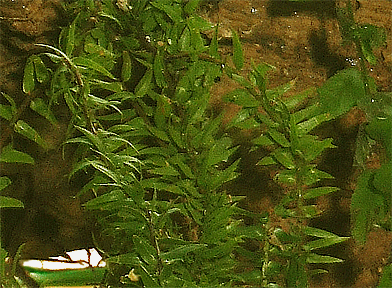 rain
forest tree. These vascular plants lack flowers and sexually
reproduce via the production of spores. Considered a
sporophyte, Huperzia phlegmaria possesses true roots
with an aerial stem. However, the leaves are scale-like and are
known as the microphylls. Spirally arranged, these club mosses
hang from the tree host on an elongated stem. Many of the club
moss species are found in Mozambique, east tropical Africa,
Tanzania, Zanzibar, Uganda, west central tropical Africa in
Cameroon, Equatorial Guinea and Gabon, Sao Tome and Principe,
west tropical Africa in Ghana, Sierra Leone, and south Africa in
Malawi. They are also found in the western Indian Ocean
including Comoros, Madagascar and also in China, eastern Asia as
well as in Japan and the Islands of Taiwan. However
Huperzia phlegmaria at least appears to be more limited to a
somewhat more narrow range. rain
forest tree. These vascular plants lack flowers and sexually
reproduce via the production of spores. Considered a
sporophyte, Huperzia phlegmaria possesses true roots
with an aerial stem. However, the leaves are scale-like and are
known as the microphylls. Spirally arranged, these club mosses
hang from the tree host on an elongated stem. Many of the club
moss species are found in Mozambique, east tropical Africa,
Tanzania, Zanzibar, Uganda, west central tropical Africa in
Cameroon, Equatorial Guinea and Gabon, Sao Tome and Principe,
west tropical Africa in Ghana, Sierra Leone, and south Africa in
Malawi. They are also found in the western Indian Ocean
including Comoros, Madagascar and also in China, eastern Asia as
well as in Japan and the Islands of Taiwan. However
Huperzia phlegmaria at least appears to be more limited to a
somewhat more narrow range.The specialized leaves are known scientifically as sporophylls and the spores are produced within the axils and are known as homosporous spores. The plant is known as a club moss because the sporophylls resemble clubs. As a result, the name club moss is commonly used for any species within the class Lycopodiopsida which are scientifically considered primitive plant species. Scientists believe the Lycopodiopsida were a dominant group of species during the Carboniferous Period. The Carboniferous Period is thought to have occurred some 354 to 290 million years ago during the Paleozoic Era. The term comes from England and applies to the deposits of coal which occur in that region. Those deposits occur throughout portions of Europe and Asia as well as well as the Midwestern and eastern regions of North America. Carboniferous is used to differentiate between the regions that bear coal and the zones of North America separated by the Mississippi River. During that period this and other club mosses were considered capable of reaching the size of a tree. As a group, they are thought to have been one source of the deposits of coal found around the world. Although Lycopodiaceae do in fact somewhat resemble mosses, they are considered to be substantially more advanced due to a vascular form. Simply, the term "vascular" refers to the highly specialized fluid conducting tissues found within species such as Huperzia phlegmaria. Within tropical rain forests the club mosses are found in moist regions both in 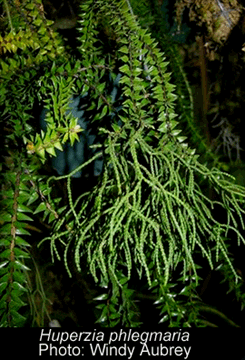 tropical and subtropical forests. However, the species within
this class are still often loosely grouped as fern allies. tropical and subtropical forests. However, the species within
this class are still often loosely grouped as fern allies.Within the classification Lycopodiaceae there has been a great deal of scientific debate, and until recent years a consensus of botanical opinion on the group has not completely been resolved. ,Some of the older scientific classifications took a much broader view of the genus Lycopodium that at one time included all the species of Lycopodiales. As a result, you can often find the species Huperzia phlegmaria for sale on plant websites as Lycopodium phlegmaria. The species is often quite costly. The more recent trend within science has been to define Lycopodium more narrowly and to reclassify the species into several genera including Huperzia which is a member of the Huperziaceae. According to information available from the Royal Botanic Gardens, Kew, "The differences given by Alston (in F.W.T.A. Pterid. and Mém. I.F.A.N. 50) to separate the species of the ‘phlegmaria’ group are slight, and certainly suspect when the immense variation accepted in India and Sri Lanka H. phlegmaria is considered (although several taxa may be confused there), and Dixit, Lycopodiaceae of India: 72 (1988) comments on the ‘variable forms’ which can be easily separated." Four of the common genera, formerly all within the genus Lycopodium, are Lycopodium, the tree club mosses, Diphasiastrum which includes the gymnosperms with common names such as Ground pine or Ground cedar. Huperzia, 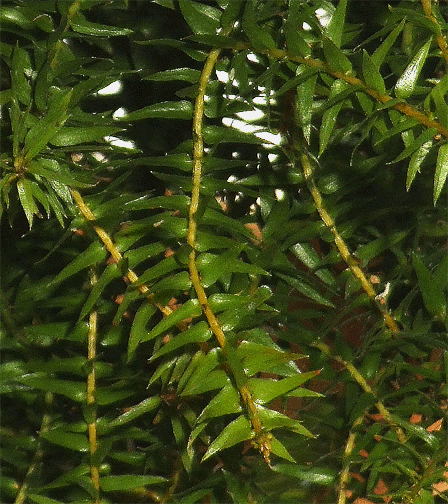 considered the fir mosses, and
Lycopodiella, which includes the bog club
mosses all of which are terrestrial. The
sole epiphytic member of the club moss family in North America
is the hanging fir moss Phlegmariurus dichotomus found
in Florida which is common in subtropical and tropical Central
and South America as well. considered the fir mosses, and
Lycopodiella, which includes the bog club
mosses all of which are terrestrial. The
sole epiphytic member of the club moss family in North America
is the hanging fir moss Phlegmariurus dichotomus found
in Florida which is common in subtropical and tropical Central
and South America as well.
Many club mosses produce spores that are
highly flammable. As a result, they were once used as an
ingredient of flash powder in the early days of photography as
well as in the production of fireworks. In addition they were
used in the production of fingerprint powders and pharmacists
also once used the spores to coat pills.
This species has many variations which often
cause it to be difficult to come to an immediate species
determination. Natural variation is common within many
plant genera and species although it is poorly understood by the
majority of plant collectors. Although the explanation
given in this link deals with other genera, the scientific
principle of natural variation are one and the same. You
may find you can better understand variation after reading this
link:
Go here.
Australian grower
Michael Pascall commented regarding similar species in this genera, "many
of these are native to the rainforests around where I live.
Friends of mine propagate them for a living . Another mate
grows them to perfection, just the way they do in nature."
On June 2, 2008 I requested a verification of
the identification of the species shown on this page from Robbin
C. Moran, Ph.D., Curator of Ferns at The New York Botanical
Garden. This was Dr. Moran's response,
"I
agree that the plant on your web site is correctly identified as
Huperzia phlegmaria"
My appreciation to Dr. Moran as well as
to Leland Miyano for their assistance
in gathering the information found on this page.
You can see our epiphyte tree here.
"
|